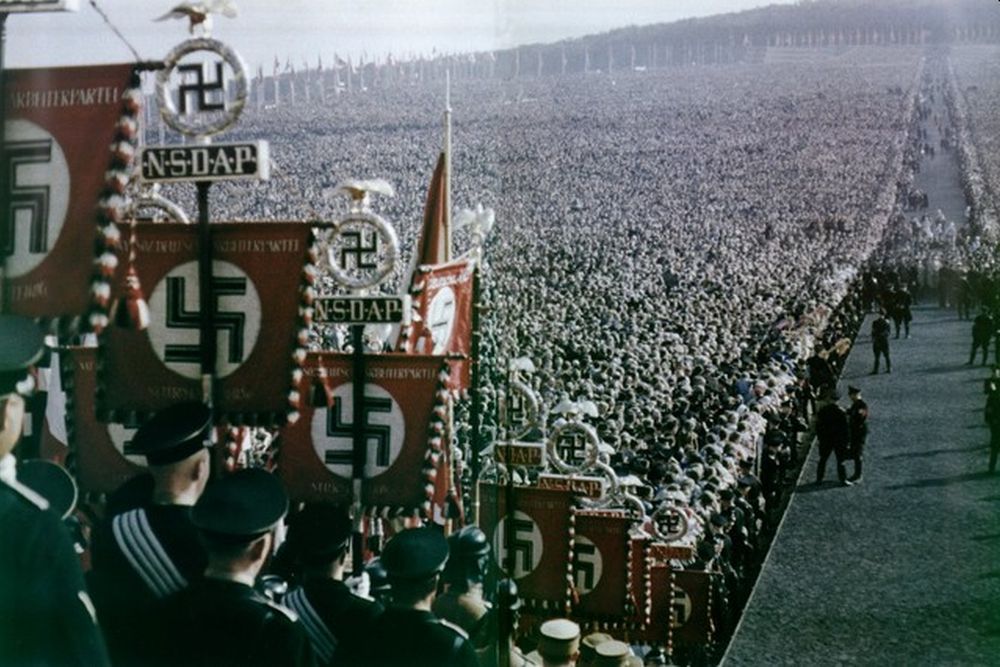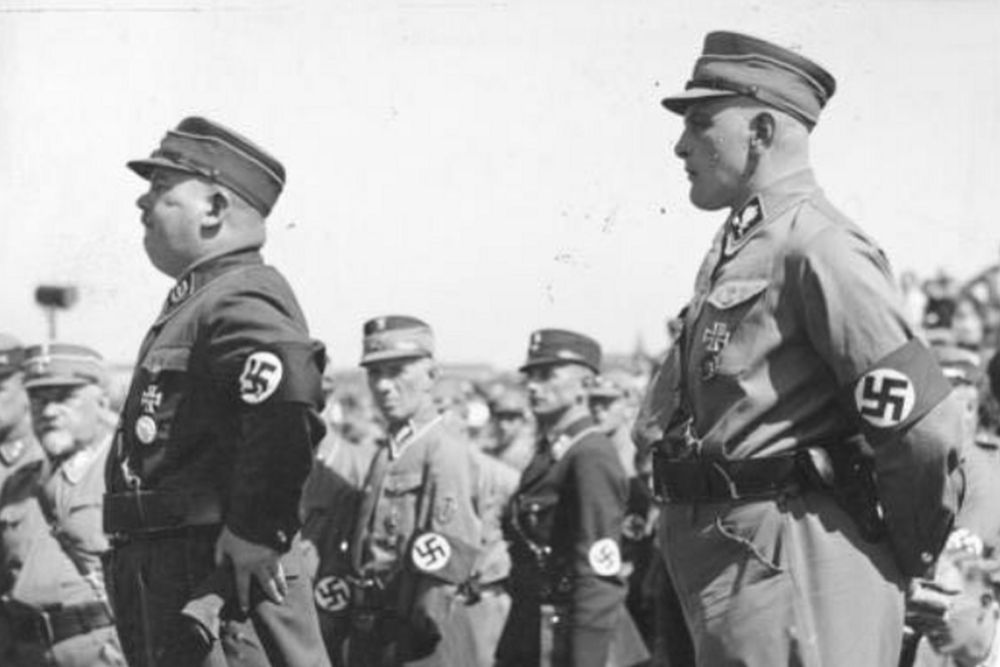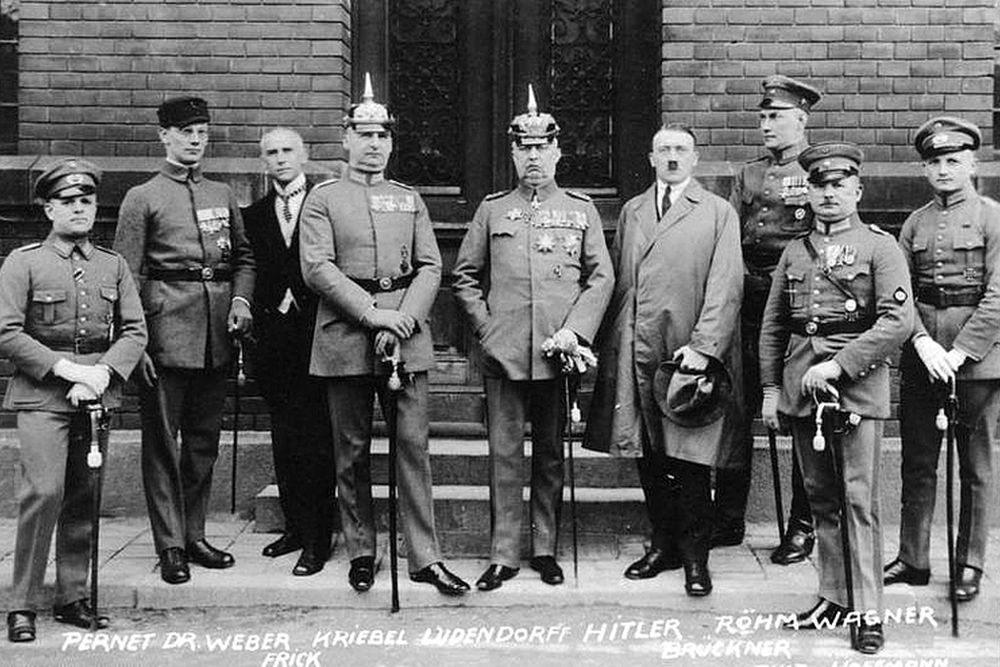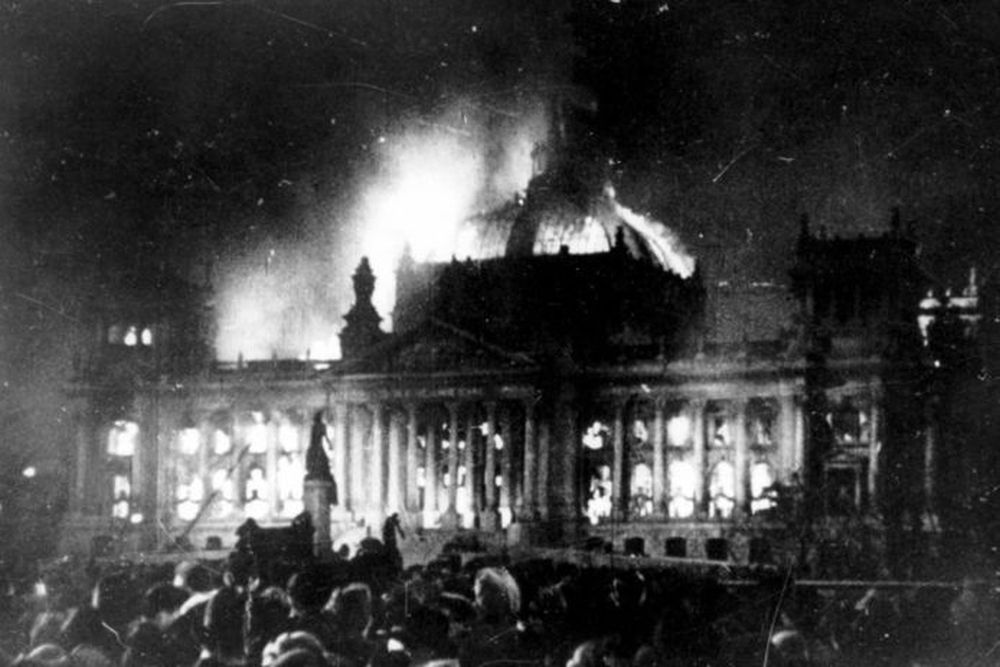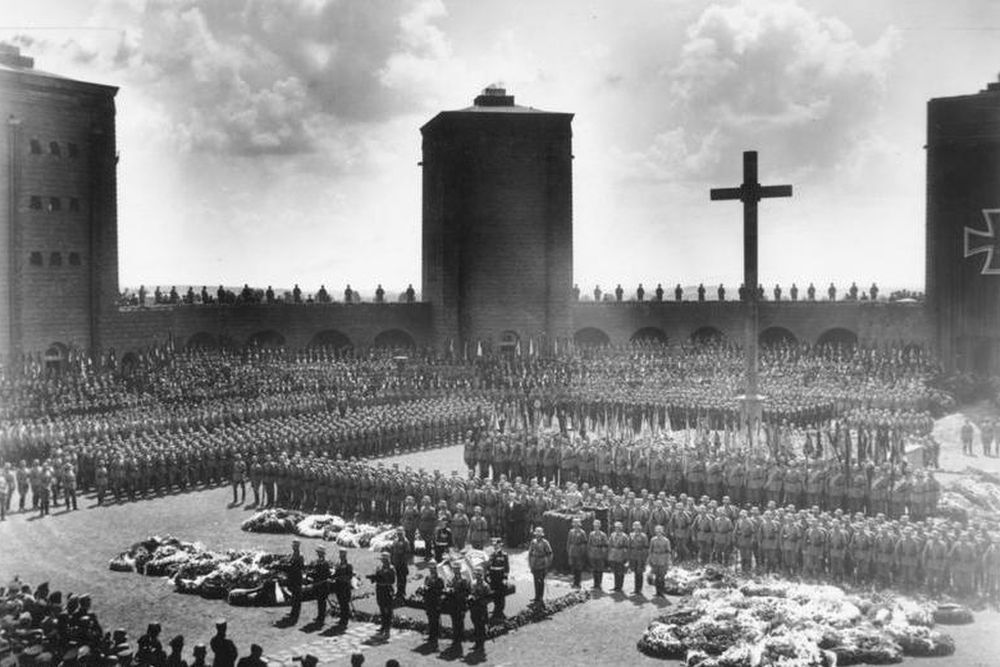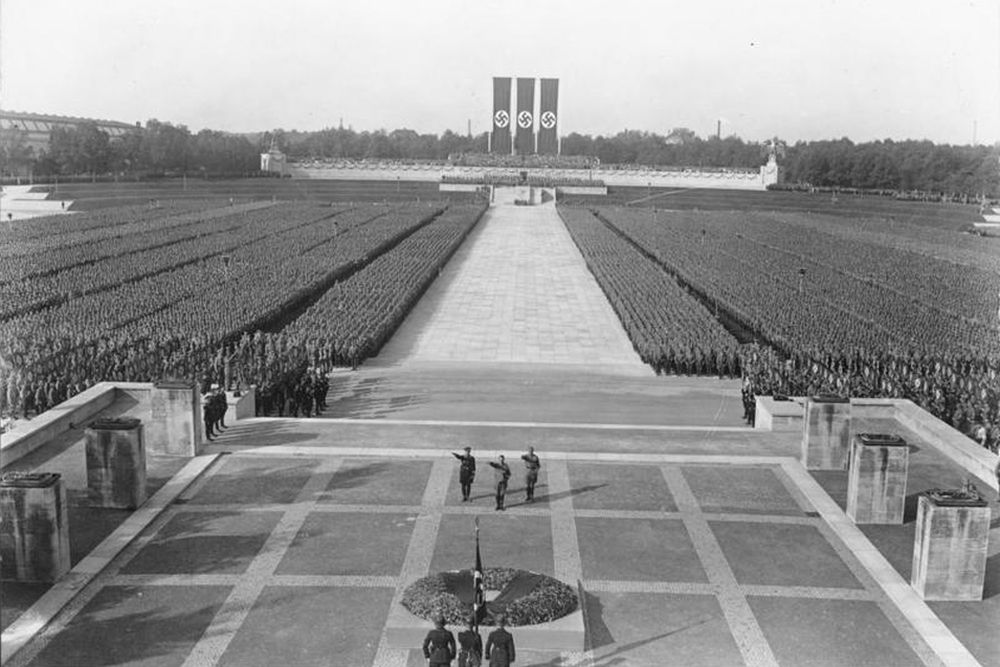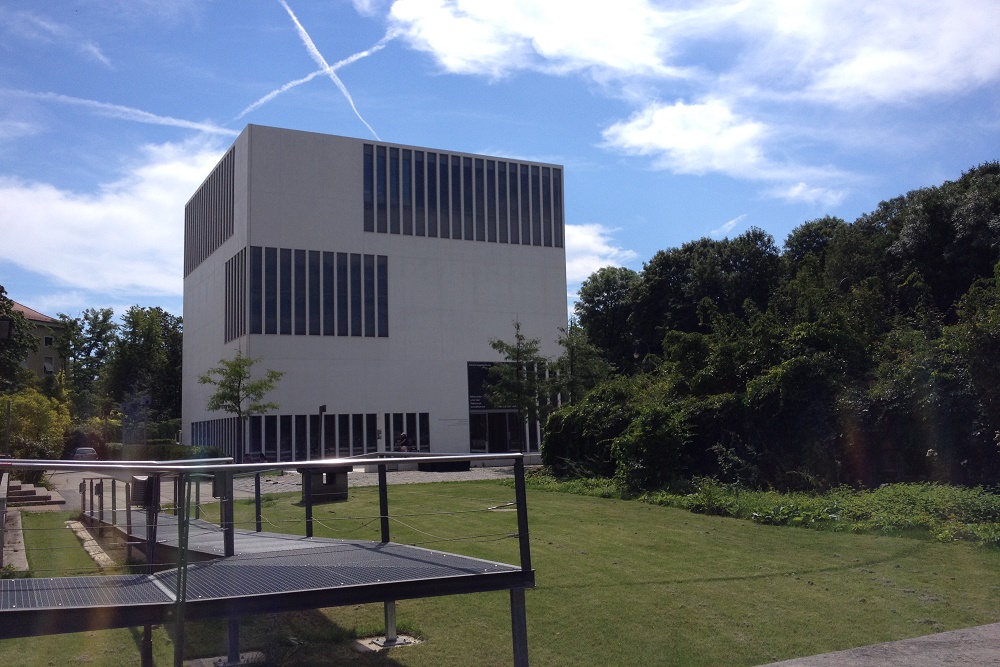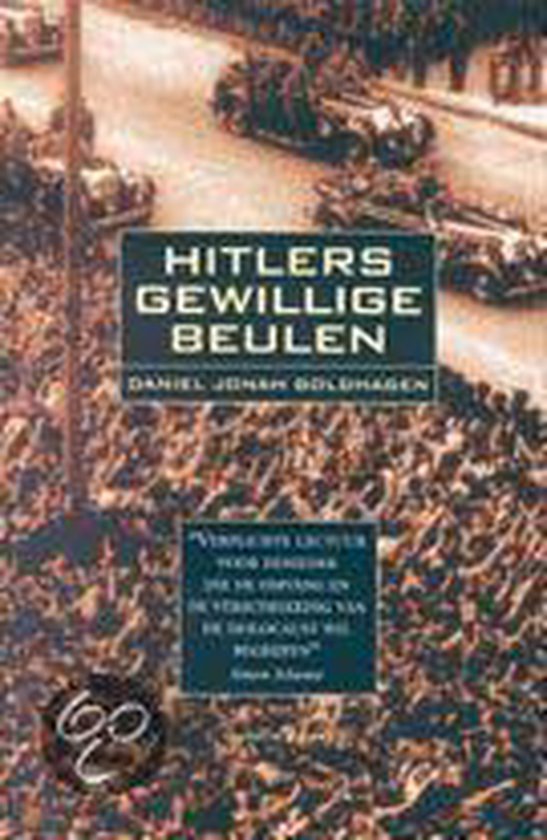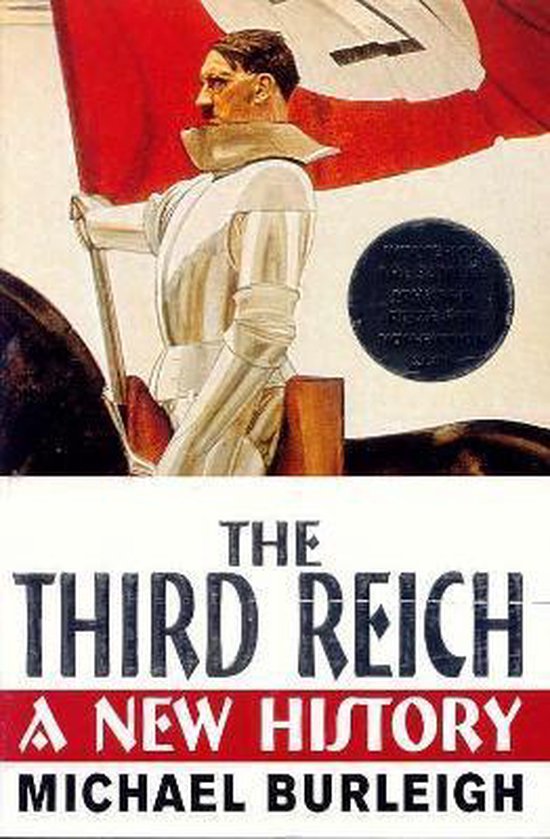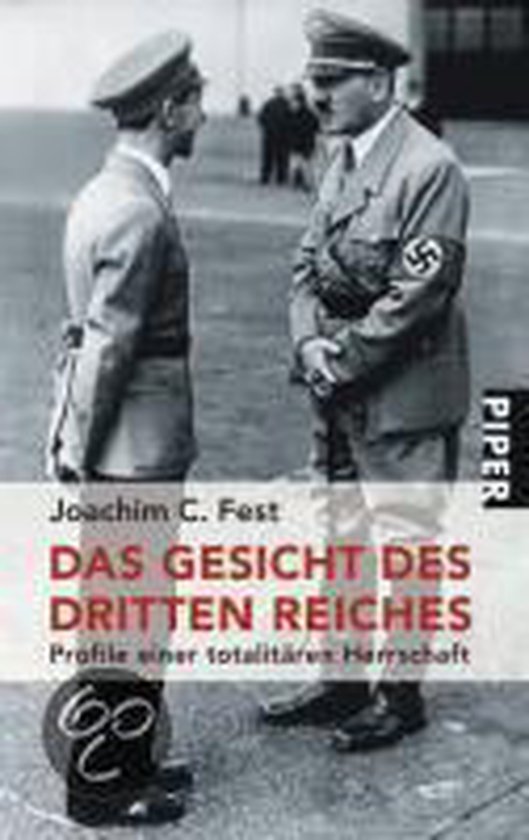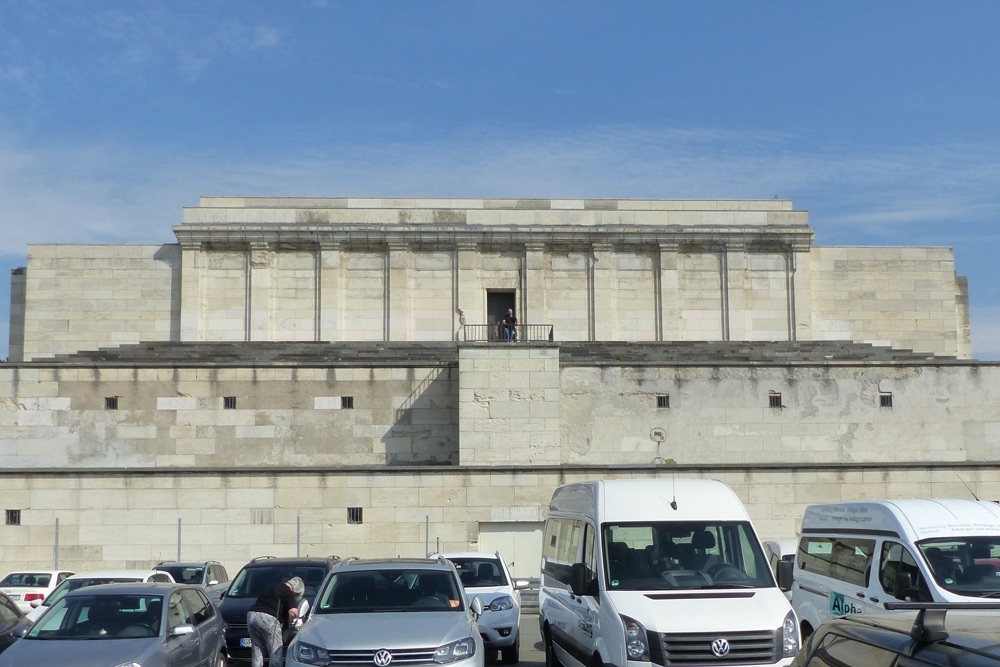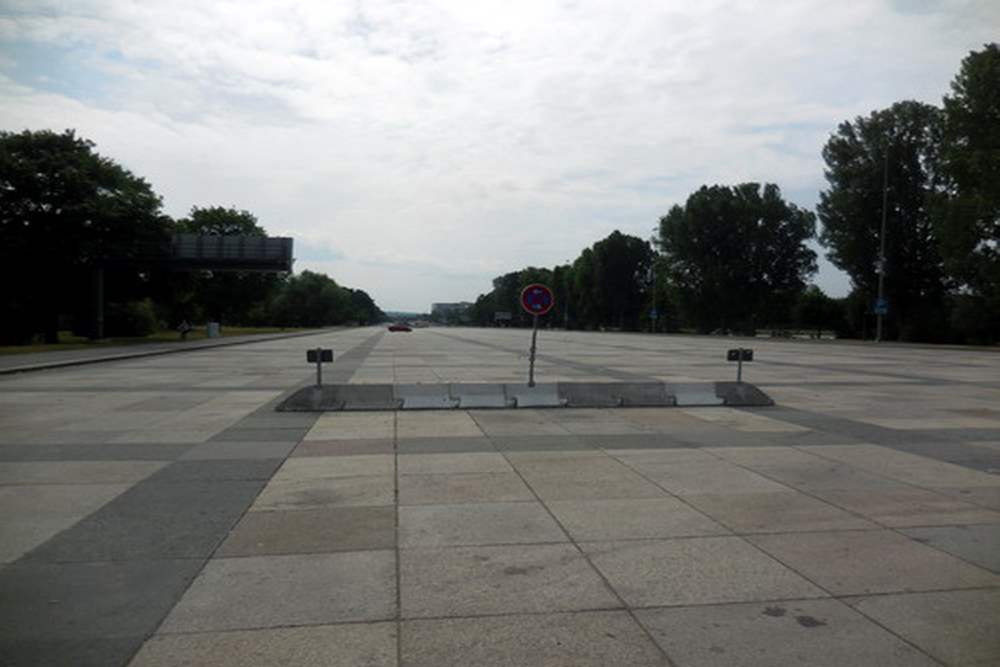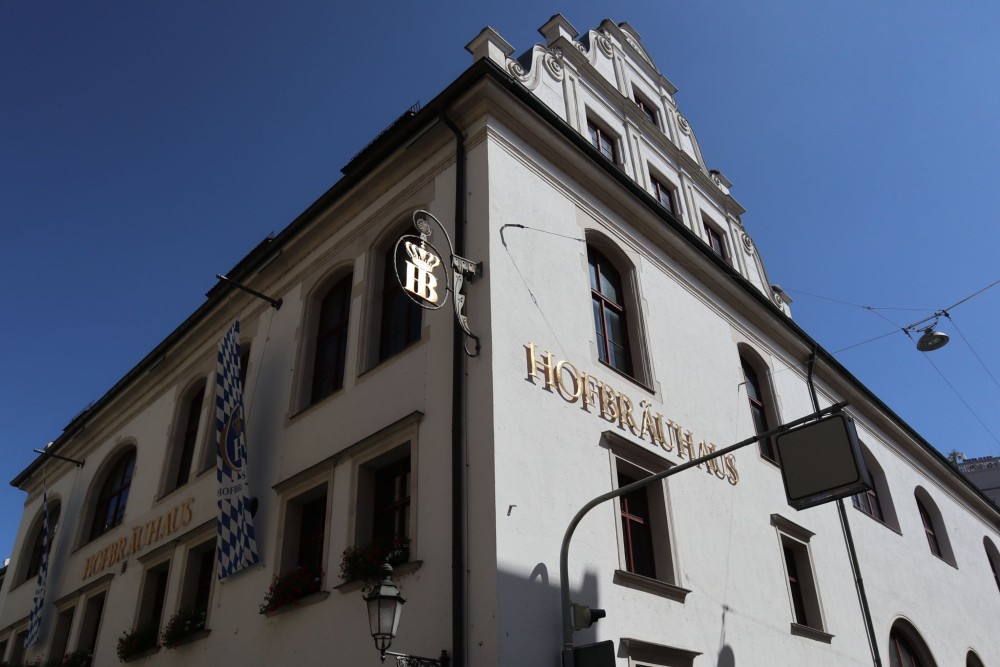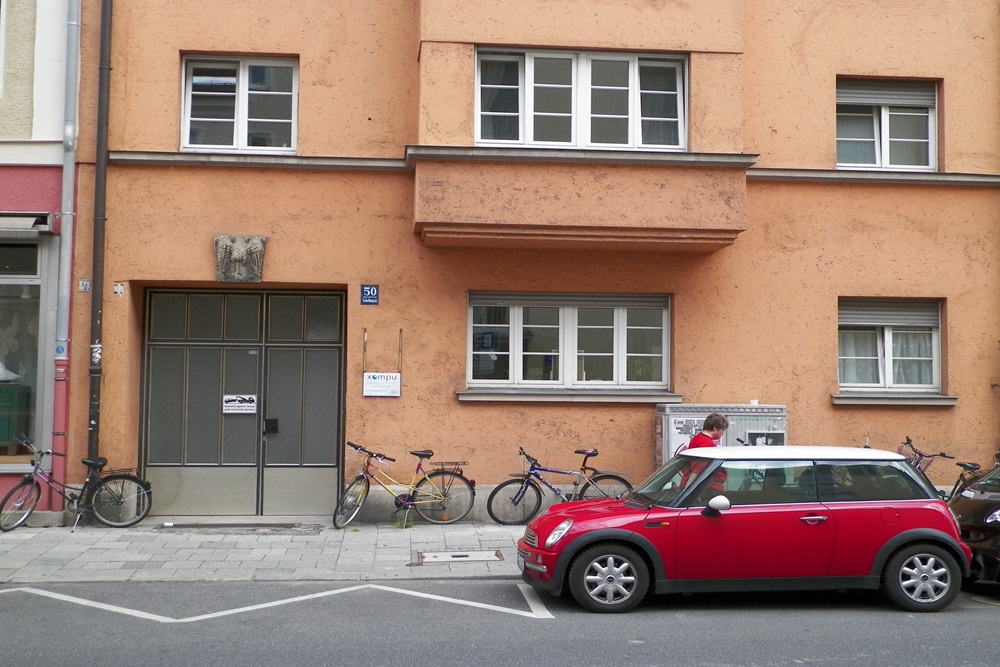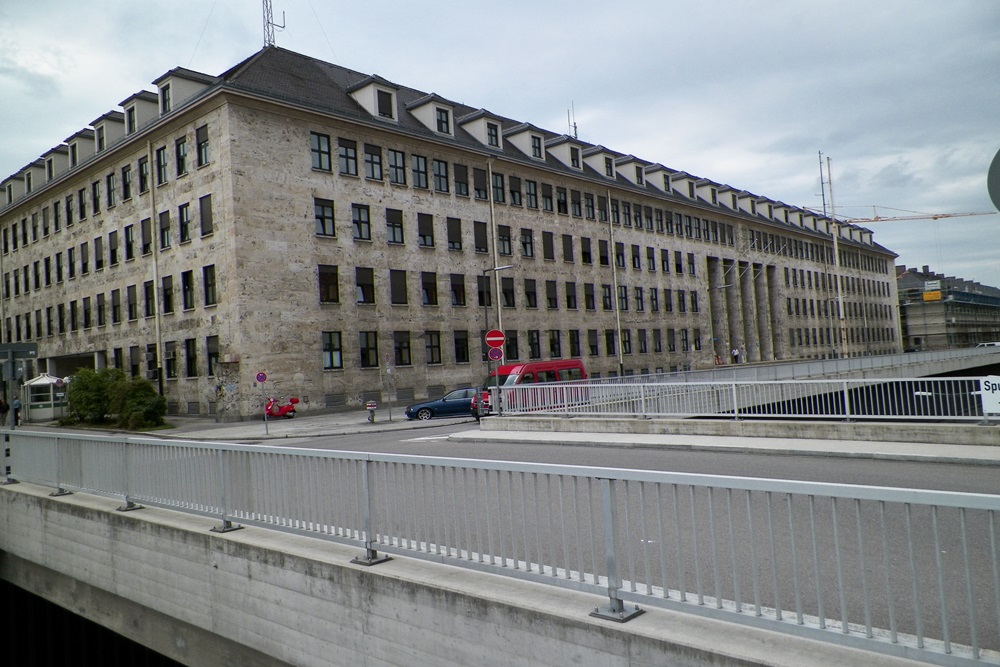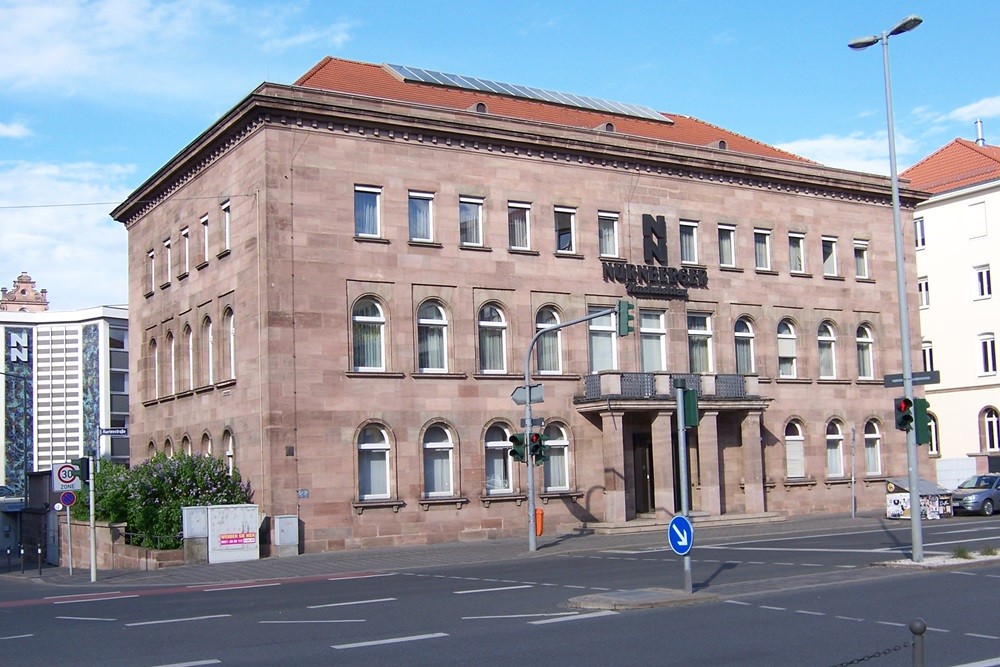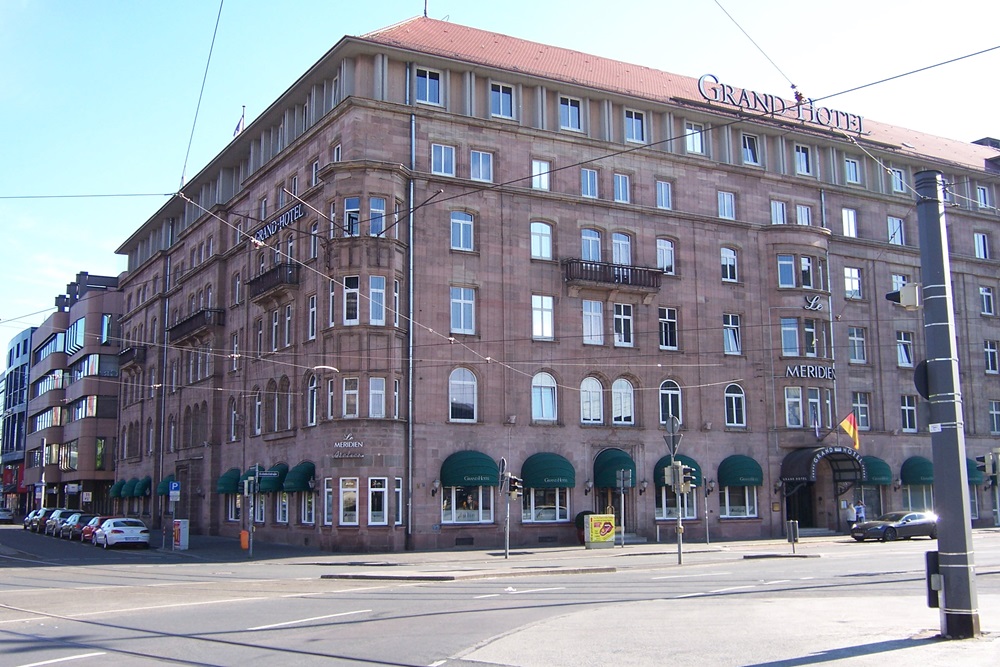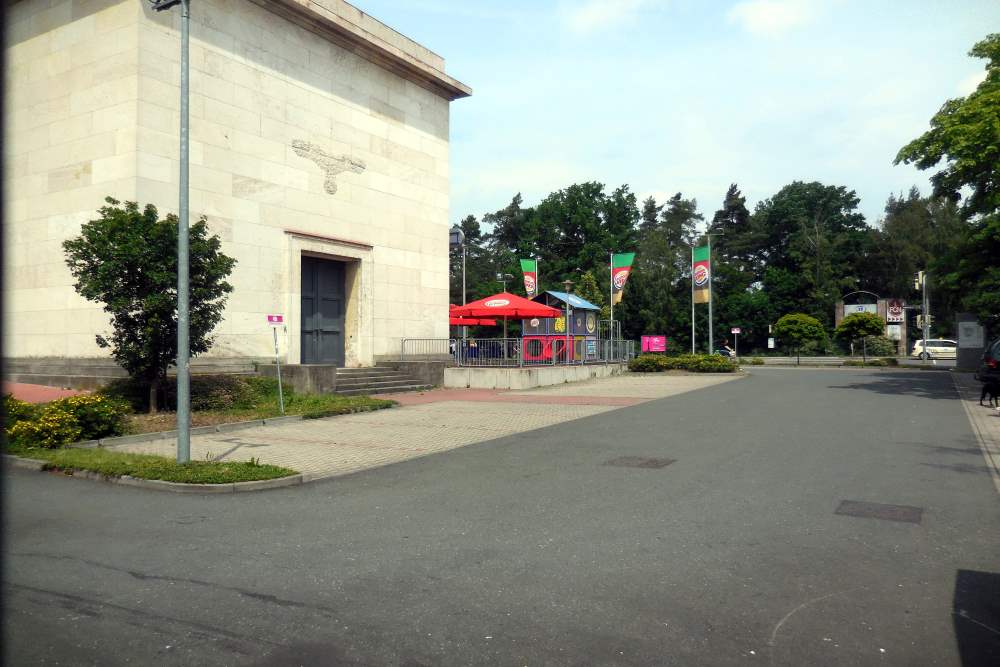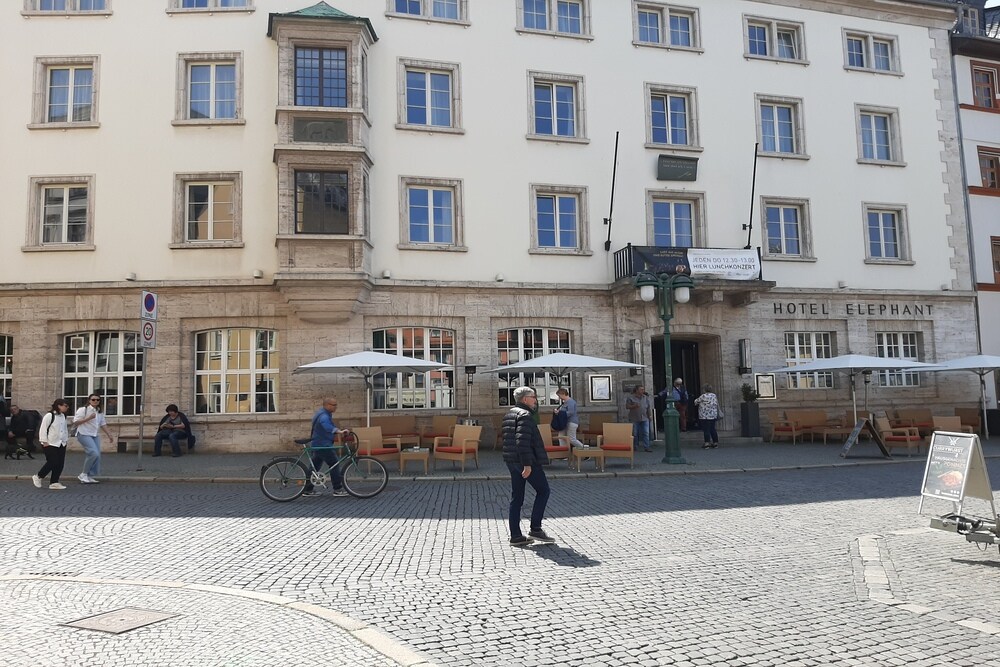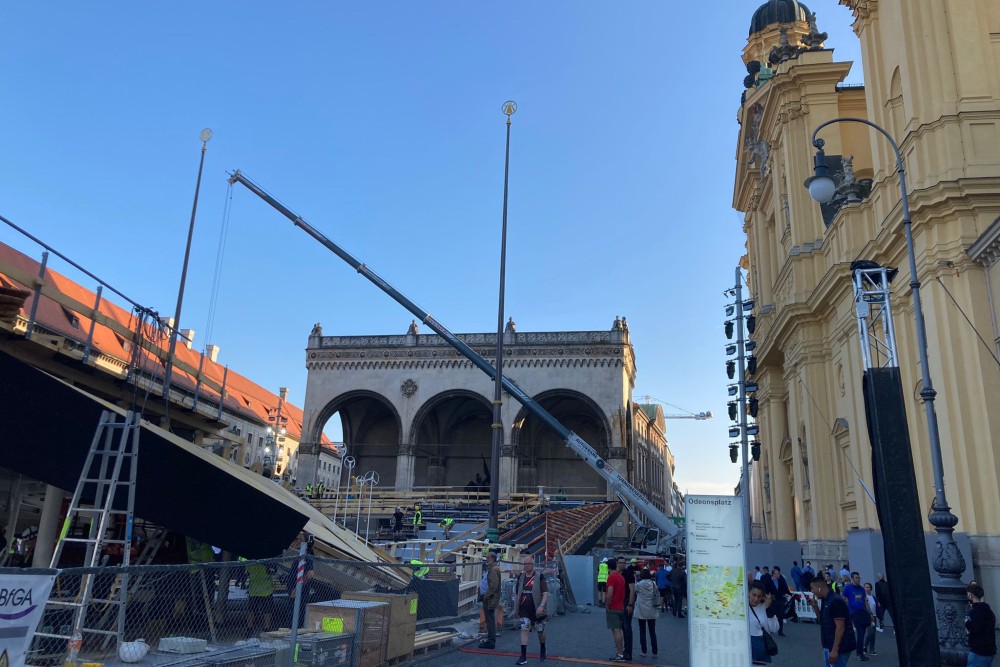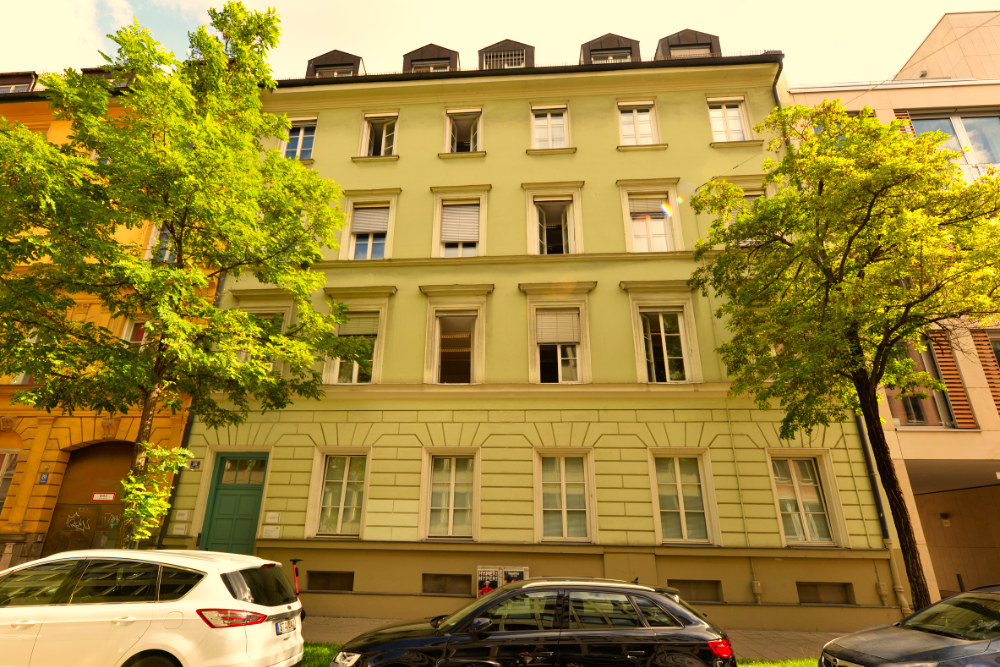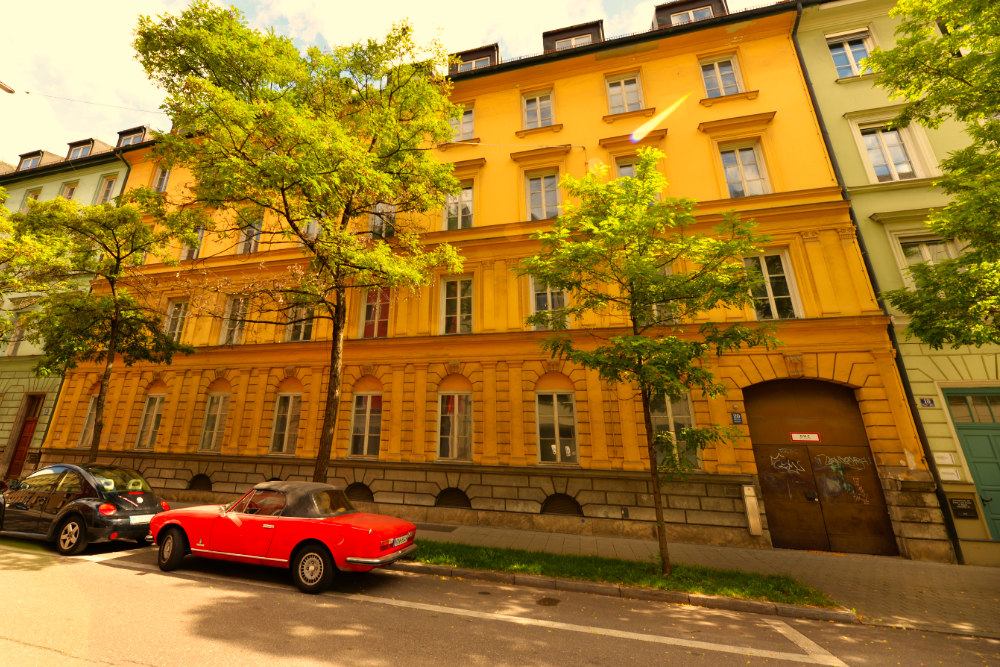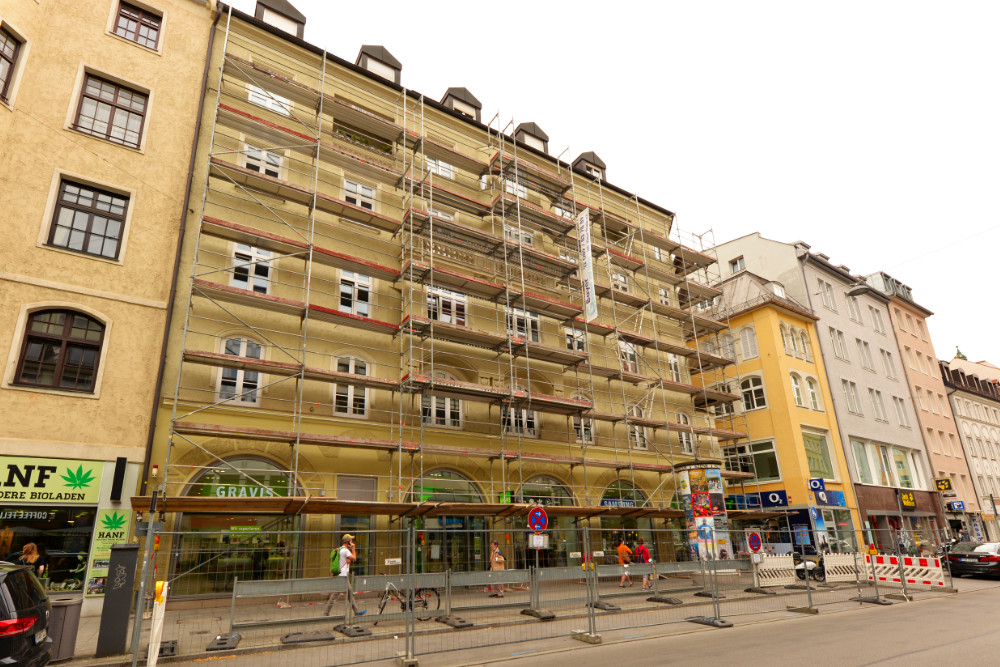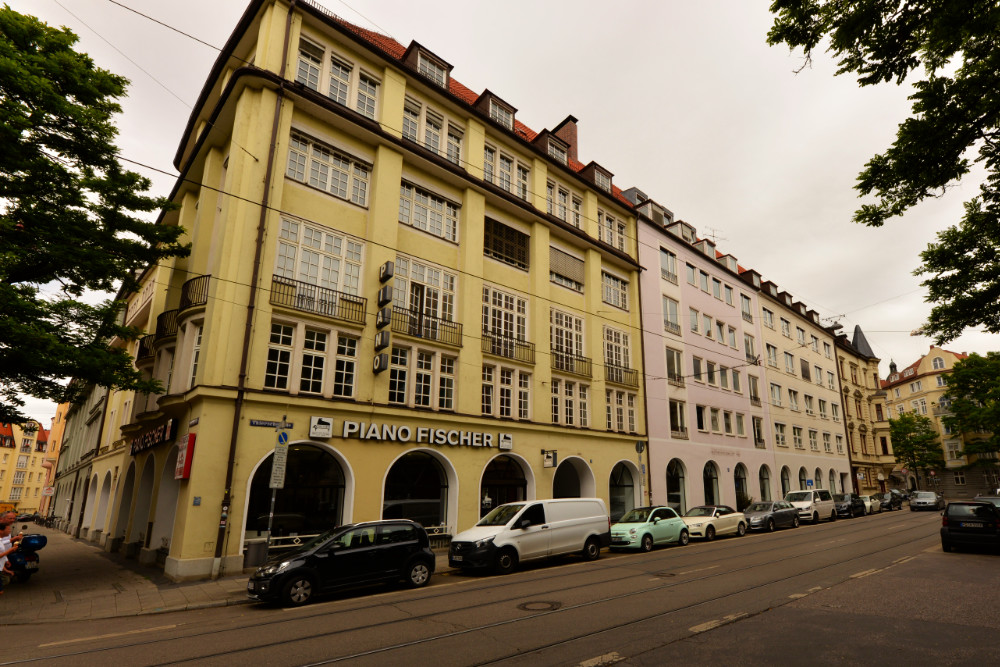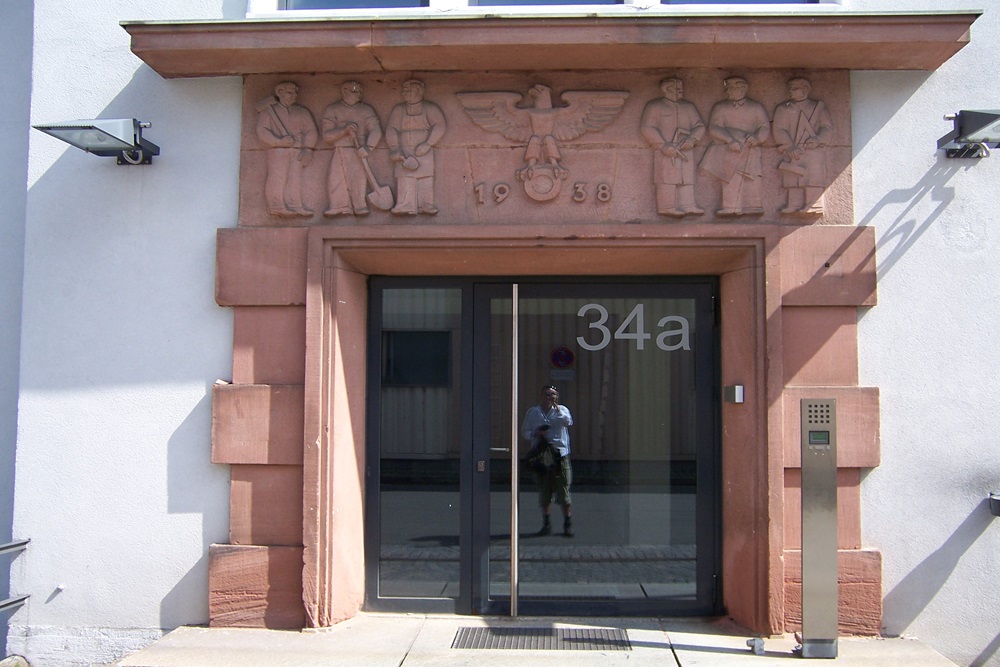Introduction
When Adolf Hitler became absolute ruler of the German Republic in 1933, the NSDAP was the largest party in Germany, in votes as well as in members. In the beginning, nobody could have dreamt that this party would number over 8 million members at its pinnacle. Without this instrument, it would have been impossible for Hitler to gain so much power. The NSDAP put a stamp on all Germans. It had grown into the ultimate tool of control. Anything and everything emanated from this party. Nothing in the life of a German could occur without this party or one of its branch organizations having something to do with it.
Definitielijst
- NSDAP
- Nazi Party, byname of National Socialist German Workers' Party, German Nationalsozialistische Deutsche Arbeiterpartei (NSDAP), political party of the mass movement known as National Socialism. Under the leadership of Adolf Hitler , the party came to power in Germany in 1933 and governed by totalitarian methods until 1945.
Prologue
How could this party gain so many followers and why particularly in Germany? In any case, we can safely say that before anyone had ever heard of Adolf Hitler or the NSDAP, anti-Semitism was already deeply rooted in German society, albeit far more extreme than in other countries. The defeat in the First World Wart and the strangulating Treaty of Versailles had hit the Germans harder than in other parts of Europe where the approaching time of crisis caused massive unemployment as well. The German population was eager to point out a (weaker) scapegoat.
Consequently, the NSDAP was able to address these issues openly so from the beginning, everyone was aware of the goals of this party. Hitler for instance, delivered a speech on August 13, 1920 with the telling title: 'Why are we anti-Semites?' The NSDAP was built on a structure that entirely matched Hitler's expectations. This structure should not include bureaucratic rules as these would only delay things; hierarchically speaking, the party obviously had authority from the top down within its organization and as to obedience from the bottom to the top. All this was aimed at ensuring Hitler to have control over all elements of the party and society.
Definitielijst
- NSDAP
- Nazi Party, byname of National Socialist German Workers' Party, German Nationalsozialistische Deutsche Arbeiterpartei (NSDAP), political party of the mass movement known as National Socialism. Under the leadership of Adolf Hitler , the party came to power in Germany in 1933 and governed by totalitarian methods until 1945.
The beginning
On January 5, 1919, the Deutsche Arbeiterpartei or DAP was founded in Munich by Anton Drexler and Karl Harrer. The premise of this party was the so-called Dolchstoßlegend (Stab in the back), meaning that the German army hadn't been defeated at the front in 1918 but at the home front. 'Defeated by the betrayal of Jews and Marxists' in the home country and by all those who had proclaimed the republic on November 9, 1918. For a while, the DAP existed only on paper while the top presented itself during meetings in small halls. As late as the spring and summer of 1919, the cadre got some shape. Drexler in particular was tasked with shaping the cadre which would be expanded by Hitler later on.
On September 19, 1919 Hitler, in his function of liaison man of the German army, attended a meeting of this party. He was to investigate the managing of organizations on the extreme right. That very month, he was registered as a member and he was soon appointed chief of propaganda of the DAP.
The first attempt at calling a mass meeting was made on February 24, 1920 in Munich. It was no great success yet: some 2,000 people listened to Hitler in a noisy room. Yet he managed to enthrall the audience and have a proposal accepted to change the name to Nationalsozialistische Deutsche Arbeiterverein or (NSDAV). As on this date the first party program was accepted, this date can be seen as the founding date of the party which would later be known as the Nationalsozialistische Deutsche Arbeiterpartei (National Socialist German Workers Party) or NSDAP. The movement soon expanded quickly and Hitler distinguished himself as a propagandist. Within the NSDAP, propaganda was soon turned into a real art which appealed to many. In 1920, the swastika was accepted as the party symbol and the Völkischer Beobachter (people's observer) became the central party organ. In December 1920, the party was restructured following Hitler's suggestion. At this reform, he took over the actual chairmanship from Drexler. As late as July 1921, Hitler formally took chairmanship of the party.
Towards 1921, Hitler had already risen to political, intellectual and ideological leader of the organization. At that moment he had appropriated various powers of authority to make decisions himself on behalf of the party. Hitler immediately shaped the party the way he wanted, according to the Führerprinzip, having full power and the party being obedient to him. The loose structure of the Ortsgruppe was replaced by a structure making the Ortsgruppe directly subordinate to the Parteizentrale. Max Amann was made responsible for this.
From the beginning, the party focused mainly on the following issues:
- termination of the Weimar democracy,
- revision of the Treaty of Versailles,
- paying back the old enemies,
- anti-Bolshevism
- militarism,
- anti-Semitism
Hitler and Drexler incorporated these issues into the party program in 1921 which has never been adapted since. The first four points of the program would later be the guide line of German policy: the foundation of a Great-Germany in which all Germans and all German-speaking others would find a place, the revision of the Treaty of Versailles, taking ownership of colonies and the removal of all Jews from Germany. From the beginning, the party was anti-Social, anti-Marxist and anti-Semitic. Hitler meanwhile had assembled a group of trustees. Among them there were a few who would follow him until the end such as Joseph Goebbels (later minister of Propaganda), Hermann Göring who as Reichsmarschall would become the leader of the later Luftwaffe, Alfred Rosenberg the party ideologist and Julius Streicher. The latter was co-founder of the anti-Jewish Deutsch-Sozialistische Partei who joined the NSDAP in 1922.
From the beginning onwards, Hitler knew the NSDAP could only succeed by organization. Everything had to be organized by themselves. Hitler got control of the press by buying a paper through sponsors, the Völkischer Beobachter. He took enforcement of law and order in his own hands by establishing a paramilitary organization, the SA (originally named the Sportabteilung) or Sturmabteilung which was converted by Ernst Röhm to a paramilitary battle group. Furthermore, organizations were founded within the NSDAP for almost all elements within society. The mindset was that in the future each citizen had to call upon a party organization for anything he wanted to undertake. In this way, the party would gain full control over the lives of the citizens.
Towards 1922, the party numbered some 20,000 members, a number that would increase to over 50,000 during 1923, the year of the crisis. In this period, the party was more like a middle class party: a party for skilled laborers and officials or the middle class. Modal we would call it today. And it was a party of former army officers. As of 1923, Alfred Rosenberg became editor-in-chief of the party paper and with that, the most important party ideologist. In relation to the entire German population, the party was still small fish. Because of its political expressions and the street terror of the SA, the NSDAP was even prohibited in Prussia and in other federal states in 1922.
Taking into account a possible collapse of the German army due to the crisis, Hitler and the organizer of the SA, Ernst Röhm, came up with the idea to establish a reserve army which they could control themselves. This reserve army became the Schutzstaffel or SS and was selected from the ranks of the SA.
Definitielijst
- DAP
- Short for Deutsche Arbeiterpartei or German Labour Party. Established by Anton Drexler in 1919. The principles of the party all had in common the perceived treason behind the frontlines during the Great War by Jews and Marxists. Hitler became a member of the party when as a military liaison officer he investigated extreme right wing parties in post war Germany. Hitler also influenced the addition of national socialist to the name of the party, thus becoming the NSDAP.
- democracy
- From the Greek: demos (the people) kratein (rules). Democracy is a form of government elected by the majority of the people in which the people can check on the leaders and have the government resign in case a majority of the people no longer agrees with the government.
- Jews
- Middle Eastern people with own religion that lived in Palestine. They distinguished themselves by their strong monotheism and the strict observance of the Law and tradition. During World War 2 the Jewish people were ruthlessly persecuted and annihilated by the German Nazis. . An estimated 6,000,000 Jews were exterminated.
- Luftwaffe
- German air force.
- militarism
- Great influence of the army on civilian society.
- NSDAP
- Nazi Party, byname of National Socialist German Workers' Party, German Nationalsozialistische Deutsche Arbeiterpartei (NSDAP), political party of the mass movement known as National Socialism. Under the leadership of Adolf Hitler , the party came to power in Germany in 1933 and governed by totalitarian methods until 1945.
- propaganda
- Often misleading information used to gain support among supporters or to gain support. Often used to accomplish ideas and political goals.
- Sturmabteilung
- Storm detachment. Semi-military section of the NSDAP. Founded in 1922 to secure meetings and leaders of the NSDAP. Their increasing power was stopped during “The night of the long knives”, 29 and 30 June 1934.
- swastika
- Equilateral cross, symbol of Nazi-Germany.
The Putsch
In the early 20s, inflation rose sky high. Attempts were made to solve the problem by printing large amounts of money but this soon caused shortages of paper and printing ink. Next it was tried to master the problem by reprinting existing notes showing the text Millionen Reichsmark as a result. To no avail however and the revolutionary NSDAP took the opportunity to grasp power. It was thought that when a small group of revolutionaries took power, backed by a number of prominent politicians, the masses would follow suit on their own. Hitler had studied history well and he thought to be able to emulate the Russian revolution.
November 11, 1923, the anniversary of the armistice in 1918 after the First World War was selected initially, this day was a Sunday though. Therefore, November 9, 1923 was chosen instead. In the evening of November 8, many leaders of the Bavarian government would be present at a meeting in the Bürgerbräukeller in Munich. That same night, the NSDAP called a party meeting in the Löwenbräukeller as a diversion. After the meeting, at which Hitler had whipped the audience relentlessly with the argument it was now the time to take action, members of the NSDAP together with armed men of the SA, barged into the Bürgerbräukeller and took the attending government leaders General Otto von Lossow, Gustav Ritter von Kahr and Colonel Hans Ritter von Seisen hostage. Meanwhile, Hitler had persuaded the former war hero General Erich Ludendorff to take charge of the coup. The hostages were forced to join the coup and the three minister had to promise they would go to their respective ministries in order to execute Hitler's orders. Although they did promise accordingly, on arrival at their ministries they immediately set about countermanding those order and alerting security forces.
Meanwhile, Ernst Röhm and 150 SA warriors had entrenched themselves in the ministry of War. The ensuing situation was far from favorable for Hitler and his followers. Due to the action of the three ministers,, the ministry of War was surrounded by the police and the army. The NSDAP then decided to take a march through Munich to the ministry in order to relieve the SA. It was assumed the economic situation was so bad, the citizens would join them in their masses. Some 2,000 men took to the streets. As police and Reichswehr had closed several roads, they were obliged to take another route than planned so they would never reach the ministry. The parade bogged down in Residenzstraße near the Feldhernhalle.
For an unknown reason, a shot rang out at a certain moment, killing a police officer. This caused the police to open fire. After this barrage, the NSDAP counted 14 dead. Skirmishes with the SA at the ministry of War claimed another two victims. After the eventual seizure of power, these people would be honored as heroes. In Munich, a tomb of praise for them (Felix Alfarth, Andreas Bauriedl, Theodor Casella, William Ehrlich, Martin Faust, Anton Hechenberger, Oskar Körner, Karl Kuhn, Karl Laforce, Kurt Neubauer, Klaus von Pape, Theodor von der Pfordten, Johann Rickmers, Max Erwin von Scheubner-Richter, Lorenz Ritter von Stransky and Wilhelm Wolf) was erected and the march was repeated every year in their memory, even during the war.
It is almost inconceivable that the Allies have never used this opportunity to get rid of all Nazi bigwigs in one fell swoop. In all those years, there had been only one bombing raid on that day.
On March 26, the trial against Hitler and the others started in Munich. It ended in triumph for Hitler. During the public hearings, he conducted his own defense and he also managed to enthrall the audience in the court room with his gift as orator. The leaders of the Putsch were sentenced but those few years of imprisonment in the luxury prison in Landsberg can hardly be considered a fitting penalty for high treason.
Definitielijst
- First World War
- Took place from 1914 till 1918 and is also named The Great War. The conflict started because of increased nationalism, militarism and neo-colonialism in Europe. Two alliances battled one another during the 4-year war, which after a dynamic start, resulted into static trench warfare. The belligerents were the Triple Alliance (consisting of Great-Britain, France, and Russia; later enlarged by Italy and the USA, amongst others) on the one hand and the Central Powers (consisting of Germany, Austria-Hungary, Bulgaria and the Ottoman empire) on the other hand. The war was characterized by the huge number of casualties and the use of many new weapons (flamethrowers, aircraft, poison gas, tanks). The war ended in 1918 when Germany and its allies surrendered unconditionally.
- inflation
- An economic process of sustained increase in general price levels and devaluation of money.(loss of purchasing power)
- Nazi
- Abbreviation of a national socialist.
- NSDAP
- Nazi Party, byname of National Socialist German Workers' Party, German Nationalsozialistische Deutsche Arbeiterpartei (NSDAP), political party of the mass movement known as National Socialism. Under the leadership of Adolf Hitler , the party came to power in Germany in 1933 and governed by totalitarian methods until 1945.
- Putsch
- Coup, often involving the use of violence.
- raid
- Fast military raid in enemy territory
- Reichswehr
- German army during the Weimar republic.
- revolution
- Usually sudden and violent reversal of existing (political) the political set-up and situations.
Organization of the Party
The revolt of the right was quelled and its leaders were imprisoned for a short time. Smart as Hitler was, he took a lesson from the situation. He concluded Germany wasn't ready for a violent turnover in the form of a short, quick revolution. The country had experienced this after the First World War as had the NSDAP in 1923. Hitler devoted his time in prison by formulating the starting points for a political turnaround. He dictated his texts, which would later become known in his book Mein Kampf to Rudolph Hess and others.
Hitler was released after just one year later and he immediately began reestablishing the NSDAP. The SS emerged as a branch of the SA as Hitler's personal body guard. Hitler had already laid down the foundation for this reorganization in Mein Kampf part 2. The base of the NSDAP remained in Bavaria with over half of the 600 newly founded Ortsgruppen the birthplace of National Socialism.
In order to be able to expand the organization, Hitler introduced the Uscha or Untersuchungs und Schlichtungsausschuß The main task of this organization was to prevent the Ortsgruppen outside Bavaria from organizing themselves too independently. The actual reestablishment of the NSDAP took place on February 26, 1925 by publishing the Grundsätzlichen Richtlinien für die Neuaufstellung der NSDAP in the Völkische Beobachter. The party was shaped centrally from the beginning. New members were to apply to a central office and not to the Ortsgruppen. Ortsgruppe München was tasked with the organization of the party and registration of new members and became the Parteizentrale in fact. Soon, various new organizations were founded such as the Nazionalsozialistische Deutsche Studentenbund and the HitlerJugend or HJ. Philip Bouhler was appointed Geschäftsführer or office chief, from that moment of Wilhelm Frick became chairman of the NSDAP fraction in the Reichstag and Walter Buch was appointed supreme judge of the party.
Gregor Strasser would soon grow into the great organizer of the party. Together with his brother Otto and Ernst Röhm he also belonged to the left wing of the party though. From the moment of reestablishment, he led the build-up of the party in Northwestern Germany. Thereafter, Gregor Strasser would become the most important man in the next reorganization of the structure of the party. From September 1928, the guide lines he laid down for the reorganization of the party would become common place. Each new branch would be set up according to these principles. Strasser constructed a horizontal structure and from 1932 a vertical one as well. After his retirement in 1932, Hitler would undo much of this structure as it gave the members too much influence. Until he stepped down in 1932, he was Hitler's deputy and he would be succeeded in the function by Rudolph Hess.
From the first party meeting on July 21, 1921, organization in the form of Gaue was discussed for the first time. Mainly because of the expansion in Northwestern Germany, a method was sought to keep the Ortsgruppen better in check. This was found in the form of the Gau. After the reestablishment, the organization was also structured according to territory, these territories becoming the first Gaue. The Gauleiter were subordinate to Hitler's deputy. During the congress of May 26, 1926, the Gaue and Ortsgruppen were designated by statute as party organs. As late as 1928, the borders of the Gaue were defined by Hitler himself in order to tighten the grip on the organization. In January 1931, 36 Gaue had been established.
Leadership of the Gau was in the hands of a Gauleiter. This function would become very important in the hierarchy of the party. The Gauleiter initiated all activities within the Gau and were directly answerable to Hitler. They were also appointed and fired by Hitler himself. Eventually, Strasser would adapt the borders of the Gaue to those of the German electoral districts. In each Gau, 25 Kreise and 250 Ortsgruppen were to be established eventually.
At the congress of May 22, the leadership of the organization was set up as well. This would later be converted to the Reichsorganizationleitung The first chairman was Bruno Heinemann, albeit in name only as Gregor Strasser was in charge. From January 1928 onwards, he held this function himself. After he had stepped down, Dr Robert Ley was appointed but he was never in function. This Leitung was abolished by Hitler and replaced by a Politische Zentralkommision chaired by Rudolph Hess.
Definitielijst
- First World War
- Took place from 1914 till 1918 and is also named The Great War. The conflict started because of increased nationalism, militarism and neo-colonialism in Europe. Two alliances battled one another during the 4-year war, which after a dynamic start, resulted into static trench warfare. The belligerents were the Triple Alliance (consisting of Great-Britain, France, and Russia; later enlarged by Italy and the USA, amongst others) on the one hand and the Central Powers (consisting of Germany, Austria-Hungary, Bulgaria and the Ottoman empire) on the other hand. The war was characterized by the huge number of casualties and the use of many new weapons (flamethrowers, aircraft, poison gas, tanks). The war ended in 1918 when Germany and its allies surrendered unconditionally.
- Gau
- “Shire”. District in the Third Reich established by the NSDAP.
- Gauleiter
- Leader and representative of the NSDAP of a Gau.
- Mein Kampf
- “My Struggle”. Book written by Adolf Hitler, outlining the principles of National Socialism.
- National Socialism
- A political ideology drawn up by Hitler based on the superiority of the German race, the leader principle and fierce nationalism that was fed by the hard Peace of Versailles. National socialism was anti-democratic and racist. The doctrine was elaborated in Mein Kampf and organised in the NSDAP. From 1933 to 1945 National socialism was the basis of totalitarian Germany.
- NSDAP
- Nazi Party, byname of National Socialist German Workers' Party, German Nationalsozialistische Deutsche Arbeiterpartei (NSDAP), political party of the mass movement known as National Socialism. Under the leadership of Adolf Hitler , the party came to power in Germany in 1933 and governed by totalitarian methods until 1945.
- revolution
- Usually sudden and violent reversal of existing (political) the political set-up and situations.
- Socialism
- Political ideology aiming at slight or no class differences. Means of production are owned by the state. Evolved as a response to capitalism. Karl Marx tried to substantiate socialism scientific.
The democratic road to power
Until 1929, the NSDAP led by Adolf Hitler remained a relatively small and unimportant party. The Reichsleitung of the party settled in Munich. Subordinate to this Leitung, various Gaue and Ortsgruppen came into being across the entire German Empire as explained above. Towards the end of 1925, the party numbered some 27,000 members, in 1926 some 50,000 and in 1928, this number rose to over 1 million. Later on, this growth would continue to 1,5 million in 1929 and 4 million in 1930.
When the impact of the economic crisis was gradually making itself felt more strongly on the population, the number of followers of the party increased quickly. During meticulously orchestrated mass meetings in Nuremberg, Hitler managed to enthrall and influence masses of people. These meetings were to continue until well into the war, examples of mass hysteria. During the Reichstag elections on May 20, 1928, the party achieved only 2.6% of the votes.
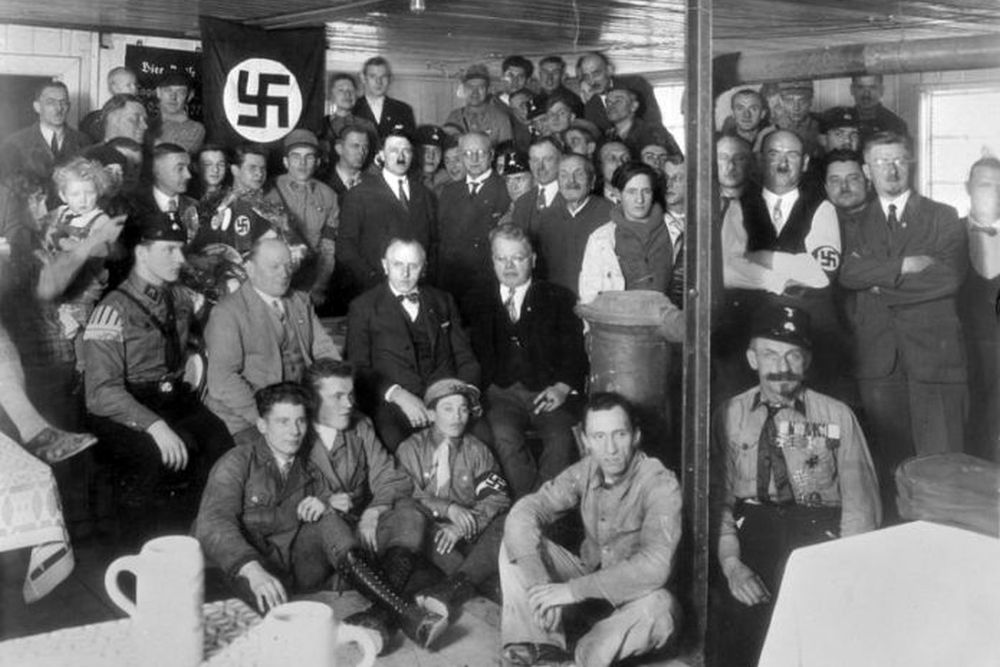
Adolf Hitler during the inauguration of the Braunes Haus in Munich, HQ of the NSDAP, 1930. Source: Bundesarchiv
During the elections on September 14, 1930, the party gained 6.4 million votes (18.3%) and it became the second strongest political power with 107 out of the 577 seats in the Reichstag, after the Sozialistische Partei Deutschland or SPD. This at a point in time when the economic situation in Germany deteriorated rapidly. Between 1930 and 1931, membership rose to 8 million.
In the winter of 1931 to 1932, the Depression had sunk to its lowest point. Unemployment was still on the rise. The only hope to break this stalemate were the 1932 elections so this year was characterized by endless election campaigns. During the presidential election in the spring, Hitler took on the incumbent president, Paul von Hindenburg - to no avail. During the parliamentary election on July 31, the NSDAP gained 230 seats, 37.4% of all votes, in other words 14 million voters and became the strongest party in Germany. For more than six months, President Von Hindenburg refused to appoint Hitler Reichskanzler. The aged and sensitive to traditions Von Hindenburg (hero from the First World War and since 1919, when the German Emperor had been forced to leave Germany) a 'substitute' emperor to many distrusted the newcomer Hitler. The cabinets that were formed on orders of Von Hindenburg (the Brüning, Von Papen and Von Schleicher cabinets) lacked support among the population and had to navigate in the Reichstag between the strong fractions of the extreme left, the Communists and extreme right, the Nazis. Although the party lost 4% during the elections of 1933, Von Hindenburg - under pressure from Prussian real estate owners and captains of industry who were not impressed by the social and political plans of the government - asked Hitler to become Reichskanzler
From January 30, 1933 onwards, Adolf Hitler stood at the head of a coalition government of the NSDAP and the Deutschnationale Volkspartei or DNVP.
Definitielijst
- First World War
- Took place from 1914 till 1918 and is also named The Great War. The conflict started because of increased nationalism, militarism and neo-colonialism in Europe. Two alliances battled one another during the 4-year war, which after a dynamic start, resulted into static trench warfare. The belligerents were the Triple Alliance (consisting of Great-Britain, France, and Russia; later enlarged by Italy and the USA, amongst others) on the one hand and the Central Powers (consisting of Germany, Austria-Hungary, Bulgaria and the Ottoman empire) on the other hand. The war was characterized by the huge number of casualties and the use of many new weapons (flamethrowers, aircraft, poison gas, tanks). The war ended in 1918 when Germany and its allies surrendered unconditionally.
- NSDAP
- Nazi Party, byname of National Socialist German Workers' Party, German Nationalsozialistische Deutsche Arbeiterpartei (NSDAP), political party of the mass movement known as National Socialism. Under the leadership of Adolf Hitler , the party came to power in Germany in 1933 and governed by totalitarian methods until 1945.
Dictatorship
One day later, Hitler disbanded the Reichstag and called new elections. By prohibiting the Kommunistische Partei Deutschland or KPD after the Reichstag fire of February 27, 1933 and having intimidated the opposition he eliminated his strongest enemies. The elections were a resounding success. The NSDAP won by 43.9% or about 17 million votes. The conclusion can be drawn from this: there were some 38,5 million voters or 8 million members of the Nazi party; still less than 20% of the adult population. This heralded the beginning of the Nazi dictatorship.
Soon, all civil rights were abolished and anti-Semitism became an inseparable part of policy. On March 20, the establishment of the first concentration camp in Dachau was announced. More would follow soon. At the pinnacle of the extermination of the Jews, Germany would number over 2,500 camps of all sorts and sizes. On April 1, 1933 the first serious signal was given in the form of the nationwide boycott of Jewish businesses. In June, this was followed by a ban on the SPD followed by a general ban on political parties in June and July. After the establishment of new political parties had been prohibited, the NSDAP became the sole party after July 14, 1933.
September 22 that year was the start of the removal of Jews from cultural life and the press. The organized extermination of Jewry began as late of September 15, 1935 with the proclamation of the Nürnberger Rassengesetze or racial laws. These stipulated meticulously what was to be considered Jewish and the Jews were stripped of their civil rights.
Hitler managed to eliminate all other political organizations by intimidation, political as well as violent or simply by a ban when the Reichstag fire was used as an excuse to put a ban on the KPD. On July 14, 1933 the Nazis succeeded in having the Reichstag pass a law prohibiting the establishment of other political parties and this created a one-party state in fact. November 12, 1933 elections for the Reichstag were called once again, voting could only be done for one list with either a yes or a no. Propaganda made it clear that refusing to vote or voting against was equal to treason. After this period, a weird situation emerged. The NSDAP was the only party but had no state authority in fact. The parliament had been disbanded and Hitler ruled. The various ministers created their own sphere of influence and competed against each other vehemently. The party felt locked out but was appeased by giving it authority over social life in Germany. When on December 1, the unity of party and state was proclaimed, the NSDAP became the state party and Germany became a one-party state.
Hitler' s rule became total when he merged the three functions of president, chancellor and Führer into one person following the death of President Von Hindenburg.
The SA was the spearhead of the violence against Jews which went beyond intimidation. Physical abuse was almost the order of the day. Proof that this wasn't limited to opponents outside the party is the murder of SA leader Ernst Röhm in 1934. Hitler considered Röhm a threat. In 1930, Röhm commanded an SA troop strength of 60,000 men. On September 2, 1930 Hitler had taken actual command of the SA by appointing himself to the Amt des Obersten SA-Führers. In 1933 the number of SA men had risen to 400,000 and it would even rise to over 4 million. The top of the SA with Röhm as Stabschef belonged to the left wing of the NSDAP. This was somewhat more socialistically minded and expected more attention to laborers. Within the SA, Röhm had much influence and with that, he had a power apparatus on his hands that could pose a threat to Hitler.
When Hitler let it be known in 1934, that the revolution had been won by the seizure of total power, it caused a certain opposition from the SA top which preferred some sort of permanent revolution and mastery of the streets by the SA. Consequently, Röhm posed a direct threat to Hitler's rule, certainly when it also became clear that Hitler wanted to limit the power and influence of the SA to the benefit of the SS. Adolf Hitler, supported by the Reichswehr had Röhm and other high-ranking SA members arrested in the night of June 30, 1934; the notorious Night of the Long Knives. Next day, Hitler had Röhm simply eliminated along with about 1,000 top SA men. Over the course of the years, Hitler managed to systematically oust from the party or make them disappear anyone from whom he expected opposition. The top of the party was to consist of a group of people loyal to him who were willing to follow him to the death, something many of them would actually do.
The NSDAP was transformed to an organization on a broad base that was able to mobilize and keep the population in check. From 1933 on, Rudolph Hess acted as Hitler's deputy and he was succeeded by Martin Bormann in 1941. The deputy was in charge of 18 Reichsleiter of the various branches within the party. The organization numbered 35 Gaue (41 from 1941), subdivided in Kreise, Ortsgruppen, Zelle and Blöcke. The Blöcke were the smallest units and numbered 40 to 60 households. A Zelle consisted of four to eight Blöcke and an Ortsgruppe consisted of three to five Zelle.
Branches of the party were the SA, SS and the Hitlerjugend or HJ. Connected organizations were for instance the Deutsche Arbeiterfront or DAF and the Nationalsozialistische Volkswohlfahrt or NSV. After 1937, Hitler reduced the number of ministers from 12 to 4: Hermann Göring, Joseph Goebbels, Wilhelm Frick and Richard Darré. All of them loyal to Hitler and each one the sole ruler of his ministry. The NSDAP actually had no political function anymore: Hitler was the sole ruler and everyone and everything was subordinate to him. In the night of November 9 to 10, this would reach its temporary 'pinnacle' when Hitler deployed all party means at his disposal in a pogrom against the Jews which would later be known as the Kristallnacht, claiming 91 dead and 267 synagogues and 7,500 shops and enterprises destroyed in an attack orchestrated by Goebbels.
Afterwards, the NSDAP wouldn't play a significant role any more other than suppressing its own people.
In September 1945, the NSDAP with all its branch organizations was prohibited by the Allies. During the Nuremberg trial, the party was labeled a criminal organization.
Definitielijst
- concentration camp
- Closed camp where people are being held captive that are considered to be anti- social, enemies of the state, criminal or unwanted individuals. These groups mostly do not get a fair trial or are condemned to doing time in a camp.
- dictatorship
- A form of government where the power in a country is in the hands of one person, the dictator. Originally a Roman regime in case of an emergency where total power would rest with one person during six months in order to face a crisis.
- Führer
- German word for leader. During his reign of power Adolf Hitler was Führer of Nazi Germany.
- Jews
- Middle Eastern people with own religion that lived in Palestine. They distinguished themselves by their strong monotheism and the strict observance of the Law and tradition. During World War 2 the Jewish people were ruthlessly persecuted and annihilated by the German Nazis. . An estimated 6,000,000 Jews were exterminated.
- Nazi
- Abbreviation of a national socialist.
- Night of the Long Knives
- Night of 30 June to 1 July 1933 during which Hitler killed many of the demanding leaders of the SA, including Ernst Röhm.
- NSDAP
- Nazi Party, byname of National Socialist German Workers' Party, German Nationalsozialistische Deutsche Arbeiterpartei (NSDAP), political party of the mass movement known as National Socialism. Under the leadership of Adolf Hitler , the party came to power in Germany in 1933 and governed by totalitarian methods until 1945.
- Propaganda
- Often misleading information used to gain support among supporters or to gain support. Often used to accomplish ideas and political goals.
- Reichstag fire
- On the 27 February 1933 the building of the German government was set on fire. The Germans could declare a state of emergency and hereby come into power. It is not known whether the fire was started by the Nazi’s or the communists. The Dutchman Marinus van der Lubbe was in any case condemned for the crime.
- Reichswehr
- German army during the Weimar republic.
- revolution
- Usually sudden and violent reversal of existing (political) the political set-up and situations.
Information
- Article by:
- Wilco Vermeer
- Translated by:
- Arnold Palthe
- Published on:
- 09-06-2023
- Feedback?
- Send it!
Related sights
Related books
Sources
- BENNECKE, H., Hitler und die SA, Olzog, München, 1962.
- BENZ, W. e.a., Enzyklopädie des Nationalsozialismus, Klett-Cotta, 1997.
- BENZ, W., Geschichte des Dritten Reiches, C.H.Beck, 2000.
- BURLEIGH, M., The Third Reich a new History, Pan books, 2001.
- FEST, J.C., Das Gesicht des Dritten Reiches, Serie Piper, München, 1997.
- GALLO, M., Der Schwarze Freitag der SA, Heyne, München, 1984.
- GOLDHAGEN, D.J., Hitlers gewillige beulen, Manteau - De Bezige Bij, Amsterdam, 2002.
- HITLER, A., Das Parteiprogram der NSDAP, München, 1928.
- HOFMEISTER, J., Aufbau und Struktur der NSDAP, 1919-1933, Philipps-Universität, Marburg, 2002.
- HORN, W., Der Marsch zur Machtergreifung, Königstein , Ts., Düsseldorf, 1980.
- PICKNETT, L. e.a., Hess, Anthos, 2001.
